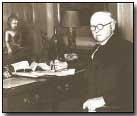Who's Who - Sir Edwin Lutyens
 Sir Edwin Lutyens (1869-1944) was
perhaps the most influential architect - and certainly the most eminent - in
determining the manner in which the Great War would be physically
commemorated. He designed numerous Great War landmarks, including the
Cenotaph in London in 1919 and the
Thiepval Memorial to the Missing, opened in July 1932 by the Prince of
Wales.
Sir Edwin Lutyens (1869-1944) was
perhaps the most influential architect - and certainly the most eminent - in
determining the manner in which the Great War would be physically
commemorated. He designed numerous Great War landmarks, including the
Cenotaph in London in 1919 and the
Thiepval Memorial to the Missing, opened in July 1932 by the Prince of
Wales.
Born in London on 29 March 1869 the eleventh child of a soldier-turned-painter, Lutyens suffered severe illness during childhood - said to be rheumatic fever - which left him in too delicate a condition to be sent to school; he was consequently educated after a fashion by one of his brothers.
At the age of 16, in 1885, Lutyens was enrolled at (what is now) the Royal College of Art to study architecture. He excelled such that he began working even while studying, and shortly afterwards determined to establish his own practice.
Lutyens was responsible for many notable buildings aside from his work with the CWGC. He designed the Art Gallery in Johannesburg, the British Embassy in Washington, both Oxford and Cambridge University buildings and the Irish National War Memorial in Dublin, among many others. He quickly demonstrated a mastery of Baroque architecture, often embracing classical styles of design.
Lutyens' talent was publicly recognised with his election as Associate of the Royal Academy in 1913. Five years later, on New Years Day 1918, he was knighted in recognition of his work in Delhi and for his free services to the Commonwealth War Graves Commission (CWGC). In 1921 Lutyens was awarded the Royal Gold Medal of the R.I.B.A. Three years later he was similarly honoured by the Institute of American Architecture, again with a Gold Medal.
In 1930 Lutyens was awarded the K.C.I.E. - again on New Years Day. Oxford University presented him, in 1934, with an honorary doctorate of Law. The same year he received a notable honour when elected President of the Royal Academy.
Receiving a royal honour for the third time in 1942, Lutyens was awarded with the Order of Merit.
Sir Edwin Lutyens died on New Years Day 1944 at the age of 73.
The Austro-Hungarian declaration of war was the first ever delivered by telegram.
- Did you know?
